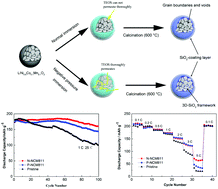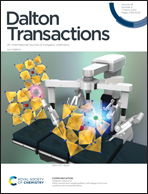Enhanced electrochemical performance of LiNi0.8Co0.1Mn0.1O2 with a 3D-SiO2 framework by a new negative pressure immersion method
Abstract
LiNi0.8Co0.1Mn0.1O2 is one of the most promising cathode materials for lithium ion batteries; however, during the charge/discharge process, it suffers from capacity fading, which is considered to be due to intergranular cracking. Herein we develop an original concept to alleviate this problem via negative pressure immersion treatment. A 3D-SiO2 framework is formed in the intergranular voids and at grain boundaries (functioning as the buffer zone and transfer-bridge) and the SiO2 protective layer is completely and homogeneously coated on the surfaces of the pristine particles through a hydrolytic condensation reaction involving tetraethoxysilane (TEOS). The 3D-SiO2 framework has two advantages: firstly, acting as a buffer zone, the framework can effectively inhibit the generation and extension of intergranular cracking; secondly, like the SiO2 protective layer on the surface of the particles, the 3D-SiO2 framework can impede side reactions between primary particles (grains) and electrolyte inside the particles. As a result, the as-modified LiNi0.8Co0.1Mn0.1O2 exhibits enhanced cycling performance with 92.4% capacity retention after 100 cycles at 1 C (200 mA h·g−1), while the capacity retention values for the pristine particles and normal coating treatment particles are only 55.4% and 82.6%, respectively. Moreover, the thermal stability (60 °C) is distinctly enhanced and the rate performance is significantly improved at high rates (2, 3 and 5 C).



 Please wait while we load your content...
Please wait while we load your content...